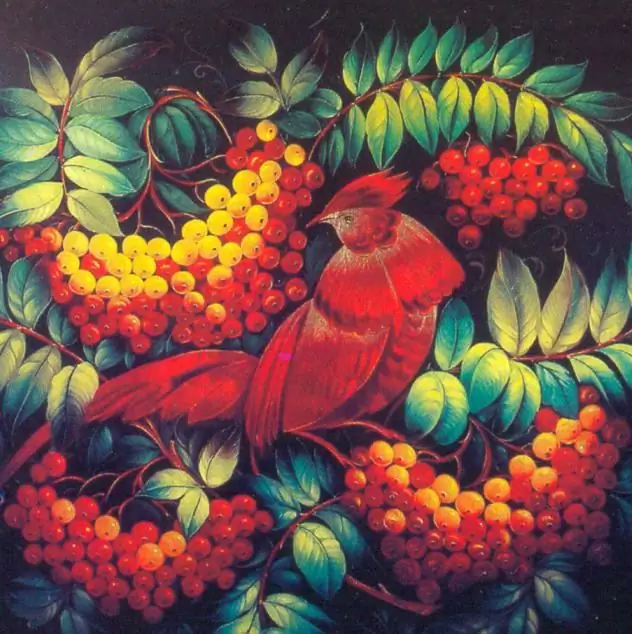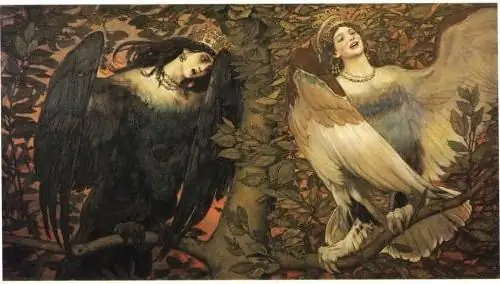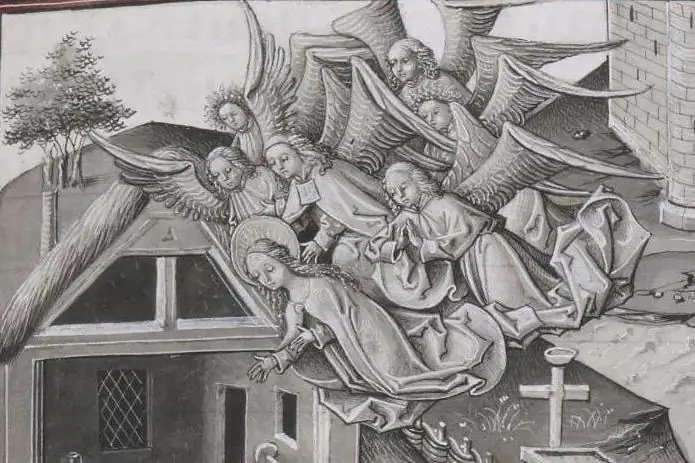2026 Author: Leah Sherlock | [email protected]. Last modified: 2025-01-24 17:46:32
Artists have long noted that color can be used to evoke strong emotional responses in people. Artists like Van Gogh were inspired by this to create masterpieces filled with many colors. However, other artists think otherwise. They strive to create a masterpiece using only one color.
Definition
Monochrome painting is a work of art painted with only one color. In fact, the word "monochrome" literally means "one color". This is a different approach to art, however, it is used much more widely than most people think.

Technique
How is a painting created if only one color is used? The key to this is that, for example, blue and green are different colors, but navy blue and cyan are not different; they are just shades of the same color. White can be added to the base color, making it lighter. Theoretically, this can be continued until almost pure white is achieved. At the same time, the color can be darkened by adding black. Thus the artistscan paint an entire image, consisting of lines, elements and shapes in different shades, which are technically a painting in one color.
Why use monochrome painting technique
Artists know how deeply color is reflected in human emotions. Monochromatic paintings have become powerful ways to provoke deep personal experiences, further encouraging artists to explore emotion and spirituality through monochrome art.
Artists reduce their color palette for many reasons, but mostly it's a way to focus the viewer's attention on a particular subject, concept, or technique. Without all the complexities of working in color, it becomes possible to experiment with shape, texture, symbolic meaning.
Monochrome painting in black, white and gray is also called grisaille.

Direction Development
The earliest surviving works of Western art made in grisaille were created in the Middle Ages. They were designed to eliminate all distractions and focus the mind. As color pervades everyday life, black and white can signal a transition to the other world or have a spiritual context.
For some, color was forbidden fruit and banned by religious orders practicing a form of aesthetic asceticism. For example, stained glass in the grisaille technique was created by the Cistercian monks in the 12th century as an alternative to bright church windows, with its translucentgreyish panels, with images sometimes painted in black and yellow. Light and elegant in appearance, the glass window grille gained popularity outside of the order and eventually became the model in many French churches.

Light and shadow studies
Since the 15th century, artists have painted in black and white to cope with the challenges posed by the subjects and compositions they depict. Color elimination allows artists to focus on how light and shadow fall on the surface of a figure, object, or scene before moving onto a full color canvas.
Grisail paintings
Increasingly, paintings in grisaille began to appear as independent works of art.
Jan van Eyck's Saint Barbara (1437, Royal Museum of Fine Arts Antwerp) is the earliest known example of monochrome work on panel painted in Indian ink and oil.
For centuries, artists have challenged themselves to imitate the look of stone sculpture in painting. Northern Europe had a taste for illusory decorative elements such as decorative wall paintings and sculpted plaster. The greatest success in this practice was achieved by the artist Jacob de Wit. His work could easily be mistaken for a three-dimensional wall relief.

Abstraction
Abstract artists often turn to monochrome painting. When artists have access to everything possibleshades, the lack of color can be all the more shocking or thought-provoking. In 1915, Kievan artist Kazimir Malevich painted the first version of his revolutionary Black Square and announced that it was the beginning of a new kind of non-representational art. The work of Josef Albers, Ellsworth Kelly, Frank Stella and Cy Tumbley illustrates the use of minimal color for maximum impact.
Artists intrigued by color theory and the psychological effects of color (or lack thereof) manipulate light, space, and hue to evoke a specific response from the viewer.
Ink painting
This kind of art allows the artist to create pronounced areas of contrast. In most cases, ink painting is the application of black ink to a white surface, resulting in this contrast. To create the necessary transitions when shading, the method of applying several layers is used. Such methods include, for example, various types of hatching.
Monochrome painting of Japan
This type of art comes from China. It was in this cultural, philosophical and artistic context that monochrome painting was born.
Of all the arts in China, painting is the most important, it reveals the secret of the universe. It is based on a fundamental philosophy, Taoism, which lays out clear concepts of cosmology, the destiny of man, and the relationship between man and the universe.
Painting is the application of this philosophy as it penetrates the mysteries of the universe.
In the traditionalChinese painting has four main subjects that are fundamentally the same in Japanese painting: landscapes, portraits, birds and animals, flowers and trees.

In Japan, during the Kamakura era (1192-1333), power was seized by warriors (samurai). In this era, thanks to the pilgrimage of monks to China and their trade there, a large number of paintings were brought to Japan. This fact greatly influenced the artists who worked in temples commissioned by patrons and art collectors (shoguns).
Import not only inspired a change in subject matter, but also promoted an innovative use of color: yamato-e (9th-10th century long scroll painting) was replaced by Chinese monochrome techniques.
The amazing works of the great Buddhist masters and painters of the Tang and Song dynasties, paintings written in black Chinese ink, were called suibok-ga or sumi-e in Japan (late 13th century). This style of painting was originally monopolized by Zen Buddhists and then adopted by monks and artists imbued with this spirit, and for a long time black ink painting and Zen painting (Zenga) were practically inseparable.
The greatest sumi master of this period is Sesshu Toyo (1420-1506), a monk from Kyoto who studied ink painting in China. Sesshu was the only artist who assimilated the philosophical basis of this kind of painting and embodied it with an original spirit in Japanese themes and artistic language, as well as in relation to the spatial representations of Chineseartists of that time.
Recommended:
Types of painting. Art painting. Art painting on wood

Russian art painting changes the color scheme, the rhythm of lines and proportionality. Industrial "soulless" goods become warm and alive through the efforts of artists. Various types of painting create a special positive emotional background, consonant with the area where the fishery exists
Zhostovo painting. Elements of Zhostovo painting. Zhostovo factory of decorative painting

Zhostovo painting on metal is a unique phenomenon not only in Russia, but all over the world. Volumetric, as if freshly plucked flowers, are filled with color and light. Smooth color transitions, the play of shadows and highlights create a bewitching depth and volume in each work of Zhostovo artists
Examples of folklore. Examples of small genres of folklore, folklore works

Folklore as oral folk art is the artistic collective thinking of the people, which reflects its basic idealistic and life realities, religious worldviews
Examples of architecture of different styles. Original examples of new architecture

World architecture developed according to the laws of church dominance. Residential civil buildings looked quite modest, while the temples were striking in their pomposity. During the Middle Ages, the church had significant funds that the higher clergy received from the state, in addition, donations from parishioners entered the church treasury. With this money, temples were built throughout Russia
Grisail technique is a type of painting. Grisaille in painting: description and features

Fans of painting and drawing lessons are probably familiar with the concept of grisaille. This is one of the most famous techniques, allowing artists to capture sculptural and architectural elements in as much detail as possible. We will tell you more about this art form below

